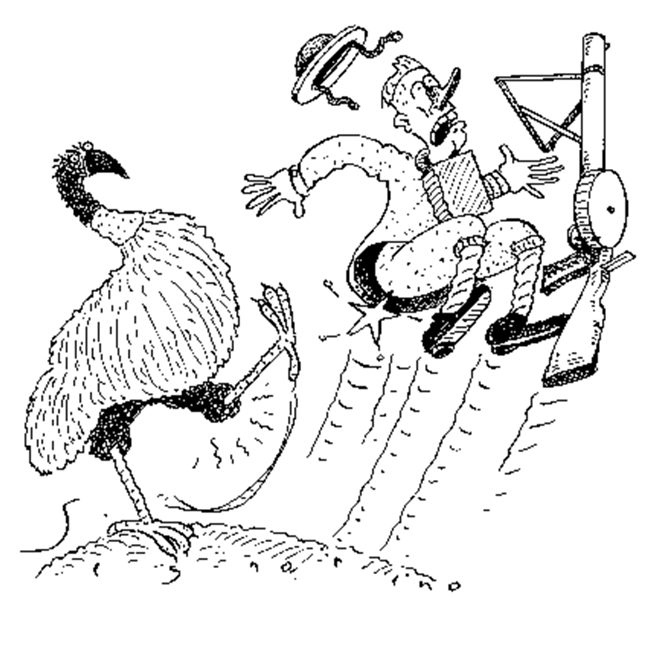Recently my roommate, an unusually trustworthy fellow, told me about the 1932 "emu war" in Australia. He said 1932 was a dry year that made 20,000 emus restless, causing them to invade a residential neighborhood en masse. The Australian military had to take them out with heavy artillery. Is this true? —Evan, Greensboro, North Carolina
Tell a story like this about virtually any other country and my reaction is going to be: this guy needs to change the filter on his hash pipe. With Australia, however, it's never wise to dismiss crazy claims out of hand. Sure enough, though the account you heard was embroidered, the essence of the emu-war story is true.
After World War I the Australian government encouraged returning soldiers to raise wheat and sheep in the sparsely populated state of Western Australia. More than 5,000 hardy souls did so, but following some initial success, most struggled. Among the challenges: uncooperative weather, rampaging rabbits and emus. (I get most of this from a 2006 article by Murray Johnson in the Journal of Australian Studies.)
The emu is a large flightless bird similar to the ostrich; it breeds in the Australian interior but ranges widely in search of food and water. Extensive fences normally kept emus out of coastal cropland, but high postwar prices led to fencing shortages, and new farms and water supplies made for attractive emu habitat. Initially considered protected game, emus were reclassified as vermin when they became pests to the farmers. Emu culls racked up high body counts, with more than 3,000 killed in 1928 alone. But it wasn't enough, and in late 1932 some 20,000 emus surged into the western wheat fields.
Facing the destruction of their crops, the beleaguered farmers sent a deputation to Perth to see ... well, you might suppose they'd have demanded an audience with the minister of agriculture. But no — these men had been soldiers before they were farmers. So they went to the minister of defense, who authorized military action against the emus, provided the farmers covered the cost of bullets, bunks and bread.
Resources assigned to the expedition consisted of two Lewis machine guns, 10,000 bullets and a pair of gunners under the command of Major G.P.W. Meredith. A Fox Movietone cinematographer was sent along to film the highlights. Arriving in the town of Campion on November 2, 1932, Meredith's troops drew first blood in a skirmish later that day, then established base camp on a local farm. The emus tended to stay near tree cover, making them unexpectedly difficult to shoot. On November 4 an ambush of 1,000 emus went awry when the machine gun jammed after only a dozen kills. An attempt to chase them with a truck-mounted gun likewise failed, as the gunner was too busy hanging on for dear life to squeeze off a single shot.
By November 8 the army had reportedly used 2,500 rounds of ammunition to kill just 200 emus, leading the prime minister to suspend the campaign while anti-emu forces regrouped. When one politician facetiously suggested that the troops be awarded medals, another retorted that the medals should go to the emus, since they had "won every round so far."
A renewed assault beginning on November 13 wasn't noticeably more effective, with a meager kill rate of 100 emus a week. The enemy proved to be fast, smart and (Meredith insisted) capable of surviving multiple bullet wounds.
By early December emu incursions had subsided, due more to the wheat harvest than casualties. Hostilities ceased on December 10. The official final tally: 9,860 bullets to kill 986 emus, an implausible ratio of exactly 10 bullets per emu. (Meredith contended many more emus had crawled away to die unseen.) The embarrassed government resisted calls to repeat the experiment over the next decade or so and instead adopted a more successful policy of supplying farmers with free ammunition and setting a bounty on the birds.
The emu war wasn't the last time the Australian army faced off against marauding wildlife. In 1992 an upsurge of feral cats in the Diamantina region of western Queensland threatened native fauna, including the letter-winged kite. So many cats were lounging in newly empty kite nests, Professor Jack Pettigrew of the University of Queensland reported, that at night their glittering eyes made the trees look like they'd been strung with Christmas lights.
Pettigrew's team culled quite a few cats, but he tells us things didn't get serious until the environment minister saw a newspaper photo of two seemingly well-fed feral cats relaxing in a nest. Cute kitties, many readers doubtless said, but the minister, evidently a bird lover, thought: these brutes must be exterminated. The army was called out and soon bagged 423 felines. No word on tactics, weaponry, or ammunition expenditure, but the lessons of history having been learned, I'm confident it was one bullet, one cat. (Thanks to Terri-Anne Kingsley for research assistance.)
Send questions to Cecil via straightdope.com or write him c/o Chicago Reader, 11 E. Illinois, Chicago 60611. Subscribe to the Straight Dope podcast at the iTunes Store.















